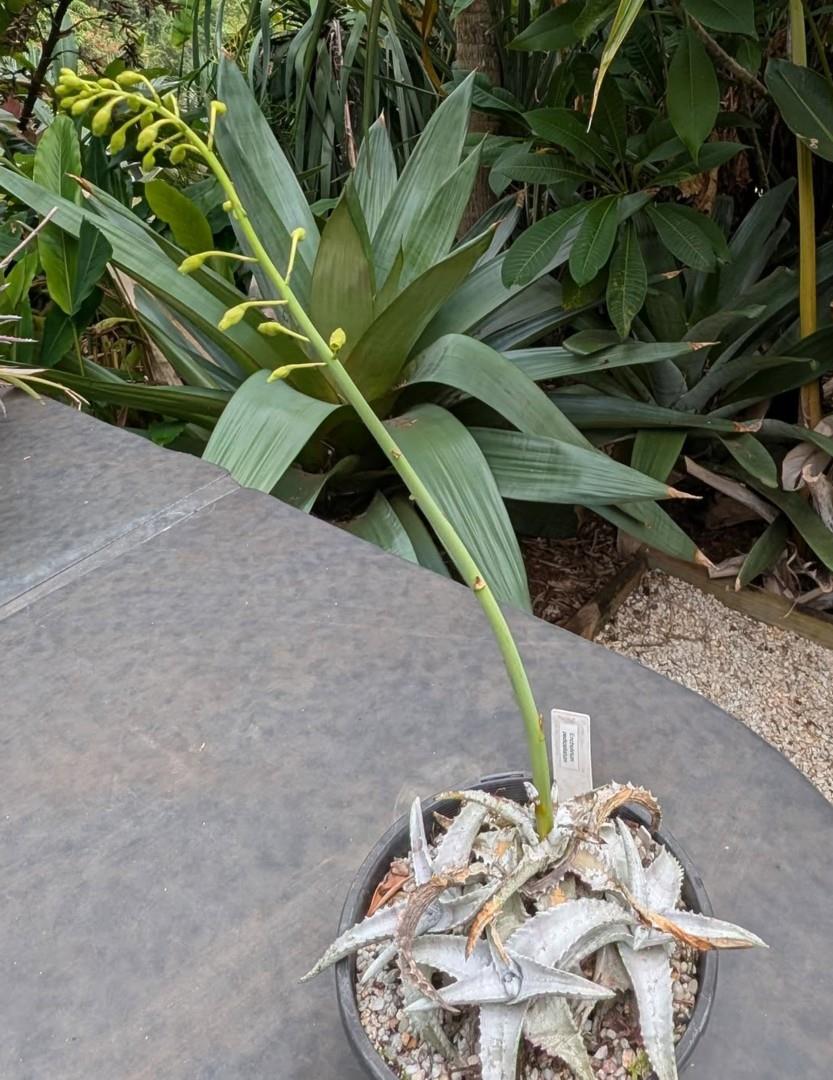
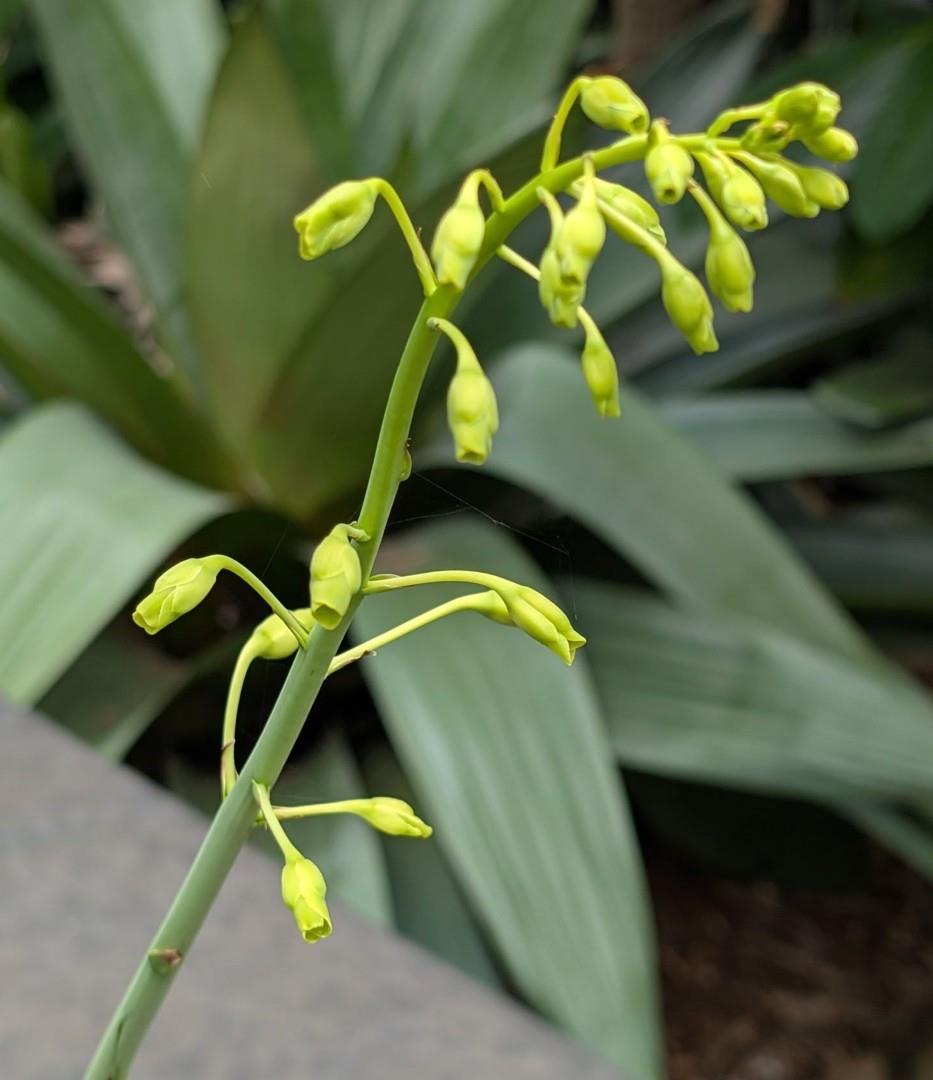
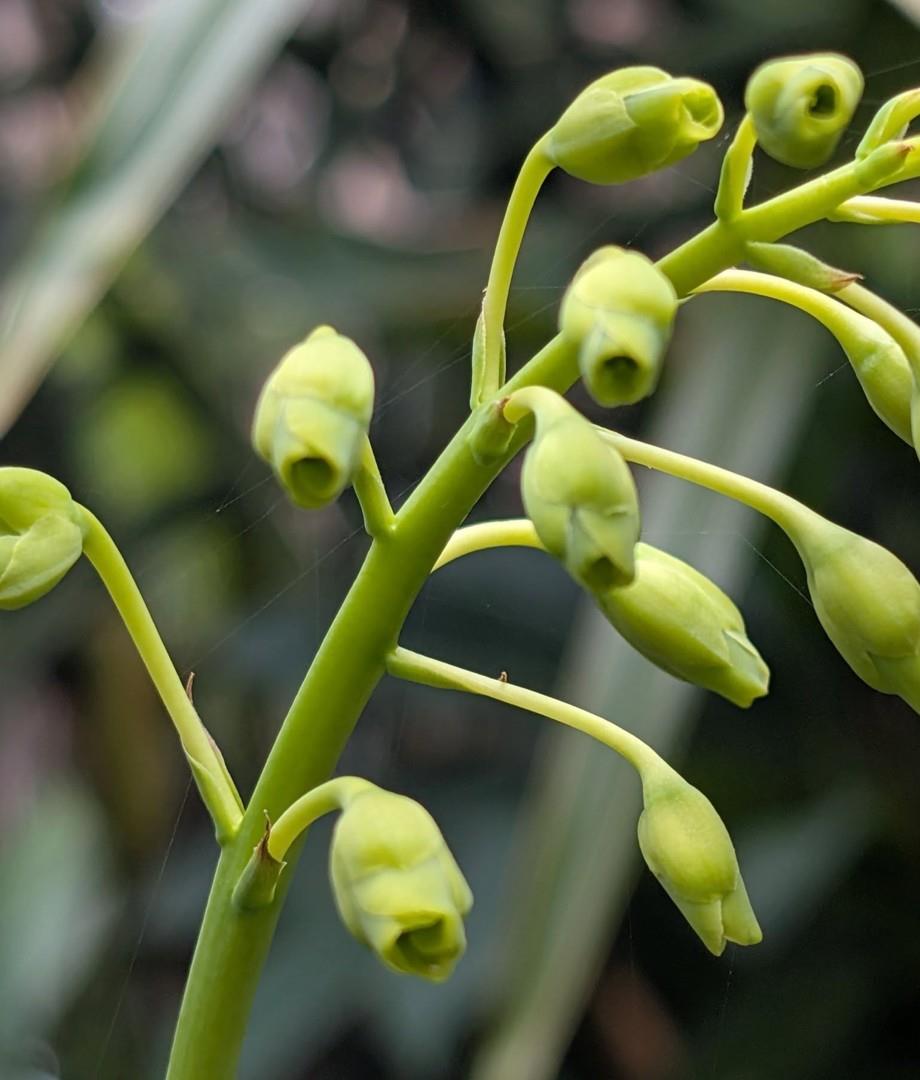
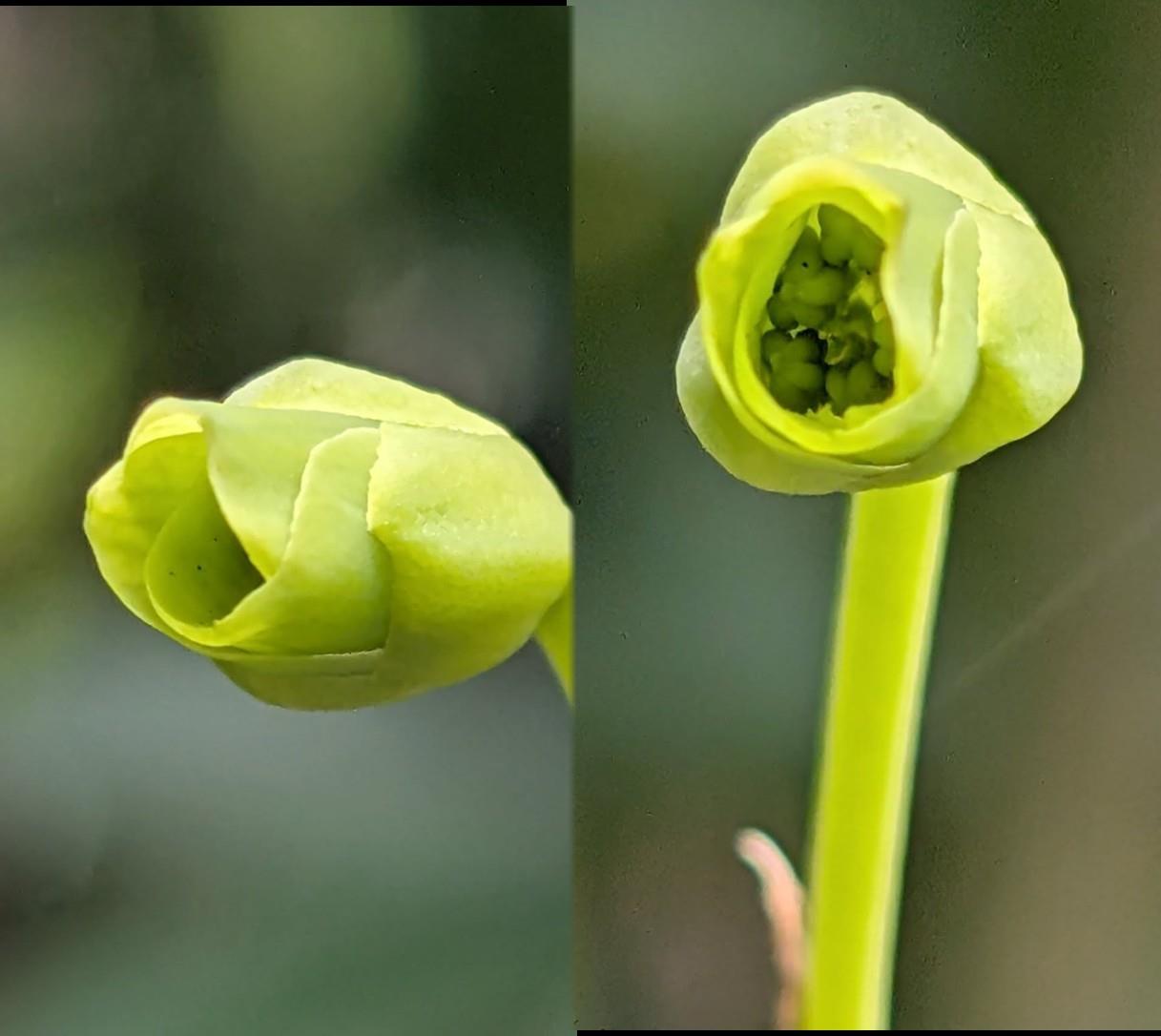
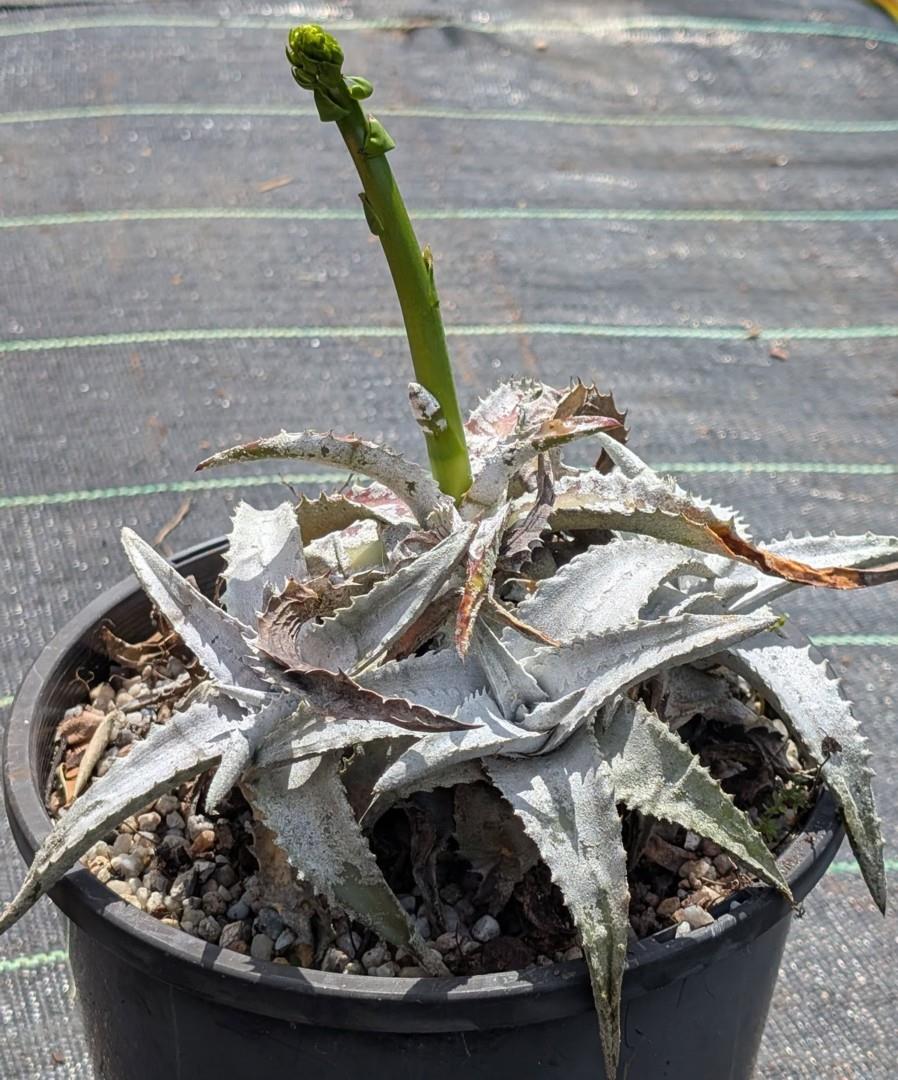
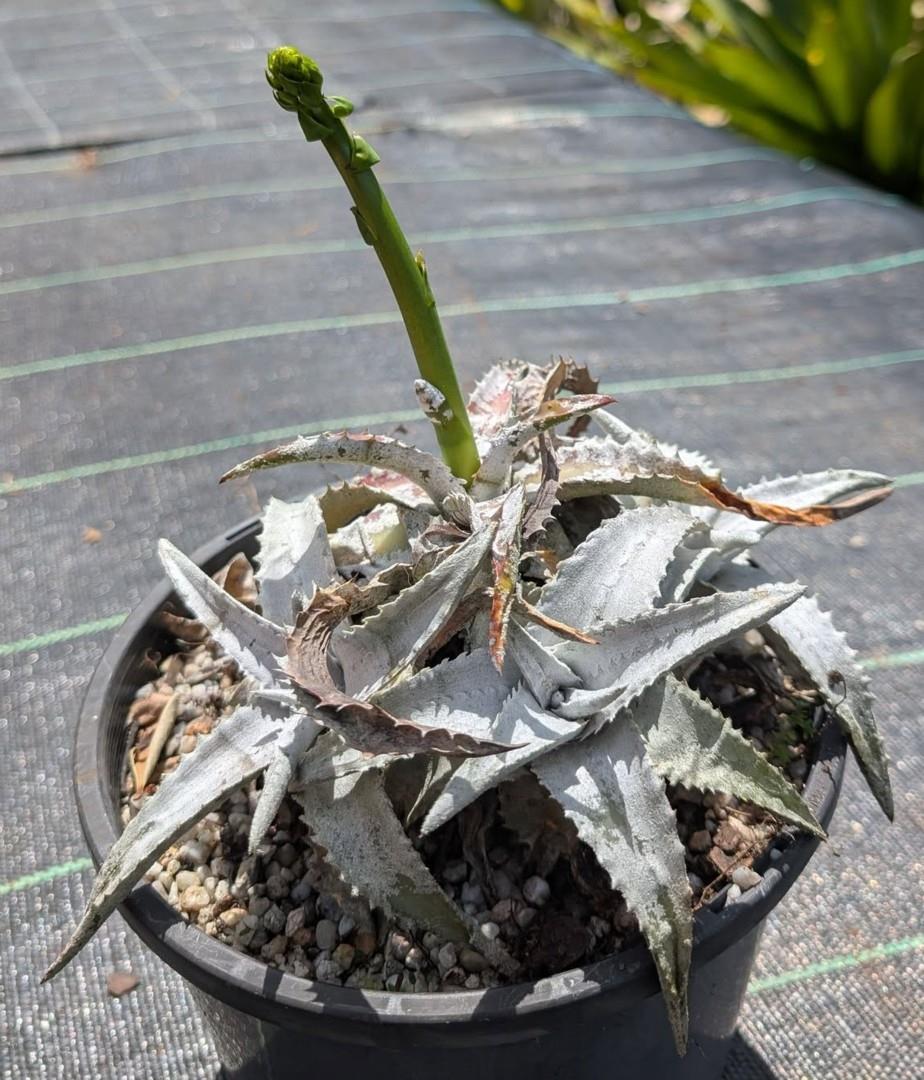
Geographical distribution, habitat and phenology: Encholirium pedicellatum is endemic to Planalto de Diamantina (MG) (Fig. 26). Seemingly, all the herbarium collections are coming from a single population, that occurs in a very restricted area. This species grows in the rocky fields, preferably in sandstone soils (Fig. 33 - A). The few flowering materials available were collected the months of January and February, except for one collection in the month of November. Examples in fruit are just known by the collection type and they were not found during the development of the present work.
Material examinado: Brasil. MINAS GERAIS. Municipio de Diamantina: estrada Diamantina-Biribiri, col. G. Hatschbach et al. 36487, II.1975, fl. (MBNI); estrada Diamantina-Biribiri, col. R. Mello-Silva et al. CFCR 8604, XI.1985, fl. (RB, SPF); estrada Diamantina-Biribiri, 3 Km a partir do trevo da BR 367, col. R. C. Forzza & R. Mello-Silva 1504, I.2000, fl. (SPF, US).
Encholirium pedicellatum was described in 1896, by the botanist Carl Mez in the genus Dyckia. Smith (1955) and Smith & Downs (1974) indicated that the positioning of this species in Dyckia was uncertain, since the available specimens in the herbaria (type collection) lacked petals and stamens, what prevented the verification of the presence of the petal-stamen ring, a character considered by the authors as a diagnostic for Dyckia. Rauh (1985), starting from specimens collected in March 1981, in the municipal district of Diamantina by Holst (56195), and cultivated in Heidelberg Botanical Garden, published an extensive description for the species, enlarging the knowledge on the morphology of this species. Rauh (1987), in a new work, transferred D. pedicellata into Encholirium, basing his decision mainly on the terminal position of the scape and in the stamens being free from the petals.
Encholirium pedicellatum was described originally from two sinotypes (Schwacke 8413 and Glaziou 19918a - Smith & Downs (1974), referred erroneously to this number as Glaziou 19198a. - This material is referred to the herbarium of Berlin (B) but it was not possible examine it) but, in spite of the works above mentioned, no author accomplished the necessary lectotypification for this taxon. In the same way, all referred, as the holotype the material Schwacke 8413. Therefore there was a need to designate a lectotype for E. pedicellata. As such, the collection Schwacke 8413 deposited in the herbarium of Berlin (B) has been chosen.
E. pedicellatum has similar flowers to E. vogelii, with the most outstanding differences between these taxa being in the rosette and the leaves. While E. pedicellatum has small rosettes with few leaves and colouration a very evident grey on both faces of the leaf blades (Fig. 33 - A), E. vogelii has wide and robust rosettes, numerous long leaves, and leaf blades completely green or slightly red (Fig.35 - A).
As well as the vegetative differences of these two species, we can still refer for E. vogelii to a well developed scape, 70 to 80 cm long, scape bracts much longer than the internodes, inflorescence many flowered, pedicels up to 3.5 cm long, floral bracts longer than the pedicels, and margin of the sepals and petals downy (Fig. 34 - A, C, D & E). On the other hand, in E. pedicellatum the scape reaches at the most 40 cm long, the scape bracts sound and much shorter than the internodes, the inflorescence has few flowers, the floral bracts are much shorter than the pedicels, that measure up to 5.5 cm, and the margin of the sepals and of the petals are glabrous (Fig. 32 -A, B & D).
Encholirium pedicellatum (MEZ) RAUH comb. nov. Trop. Subtrop. Pflanz 60: 15-6. 1987.
(Syn. Dyckia pedicellata MEZ, DC. Monogr. Phan. 9, 515, 1896; Typus: SCHWACKE 8413, S. Abb. 8)
Eine detaillierte Diagnose von Encholirium pedicellatum (= Dyckia pedicellata) findet sich bei RAUH, Bromelienstudien 17. Mitteilung, Tropische und subtropische Pflanzenwelt 53, 1985.
Innerhalb der Gattung Encholirium stellen die vorstehend aufgefuhrten Arten einen eigenen Formenkreis dar, der charakterisiert ist durch die auffallend verlangerten Pedicelli. Interessanterweise nehmen these longipedicellaten Arten ein ziemlich eng umgrenztes Areal ein. Sie finden sich alle in der naheren und weiteren Umgebung von Diamantina (Minas Gerais), in Hohenlagen von 800-1200 m. Verf. ist davon uberzeugt, dag in der gebirgigen und schwer zuganglichen Gegend von Diamantina weitere Sippen aus dieser Gruppe gefunden werden (s. auch Anhang S. 94). Weitere Neufunde mussen zeigen, ob diese longipedicellaten Arten aufgrund ihres von Encholirium abweichenden Blutenbaues nicht in einer Untergattung zusammengefaBt werden konnen.
Dyckia pedicellata MEZ by Rauh, in Trop. Subtrop. Pflanz. 53: 58-62. 1985
Es wurde bereits auf S. 52 erwahnt, daB in der Originalbeschreibung von Dyckia marnier-lapostollei die Umgebung des kleinen Stadtchens Diamantina, Minas Gerais, als Standort angegeben wird. Wohl wachst dort auf Sandsteinkonglomeraten eine Dyckia in groBen Rasen (Abb. 29), die jedoch nicht in den Verwandtschaftskreis von D. marnier-lapostollei gehort. Wir hielten these Pflanze, von der wir damals keine Bluten sammeln konnten, die einen extrem xerophytischen Charakter zeigt und in der Kultur - im Gegensatz zu D. marnier-lapostollei - sehr schlecht und langsam wachst, zunachst fur eine neue Art, bis in den Kulturen von HORST ein, allerdings etwas kummerliches, Exemplar zur Blute gelangte. Da die Petalen grunlich (und nicht orangerot) sind und auffallend verlangerte Pedicelli besitzen, durfte unsere Pflanze (Rauh und Horst Nr. 56 195) in den Verwandtschaftskreis von D. pedicellata Mez gehoren, fur die als Standort gleichfalls Diamantina angegeben wird. Unsere Pflanze weicht allerdings in einigen Merkmalen von jener ab: Sie ist kleiner, bluhend nur bis 30 cm hoch; der Schaft ist kahl; die Schaftbrakteen sind dunn und kahl (nicht dick und dicht weiB-filzig); die Pedicelli sind maximal 15 (nicht 20-25) mm lang, abet viel langer als die floralen Brakteen.
Wir lassen zunachst die Frage offen, ob these Unterschiede zur Begrundung einer neuen Art ausreichen, zumal das zur Blute gelangte Exemplar nicht voll entwickelt war . Dennoch geben wir nachfolgend eine Beschreibung unserer Pflanze, zumal die von MEZ fur D. pedicellata gegebene Diagnose recht kurz und unvollstandig ist; vor allem fehlen die Blutenmerkmale:
Pflanze infolge basaler Sprossung groBe Rasen bildend (Abb. 29), bluhend his 30 cm hoch. Einzelrosetten mit kurzem (3 cm langem), dickem, von alten Scheiden umhulltem Stamm. Lebende Rosettenblatter +/-6, sehr hart und auffallend sukkulent. Scheiden +/-1 cm hoch, 2.5 cm breit, oberseits weiB, kahl, unterseits grau lepidot. Spreiten bis 10 cm lang, oberhalb der Scheide bis 2.5 cm breit, zuruckgekrummt; Rander stark aufwarts gebogen, sich im oberen Drittel zu einer sehr harten, oberseits schmal-rinnigen Spitze verschmalernd (Abb. 30, oben), beiderseits sehr dicht weiB lepidot und dadurch silberweiB erscheinend; Blattzahne hart und stechend, retrors, ca. 3-4 mm lang, abgeflacht, braun bespitzt, dicht lepidot (Abb. 30). Inf1oreszenz einfach. Schaft aufrecht, bis 15 cm lang, an der Basis +/-5 mm dick, kahl, grun, grau bereift. Schaftbrakteen langlich-lanzettlich, lang zugespitzt, bis 10 mm lang, an der Basis 5 mm breit, am Rand glatt, kahl, nur an der gekielten Spitze sehr zerstreut weiB lepidot, aufrecht, dem Schaft anliegend, viel kurzer als die Internodien, fruh braun vertrocknend und dann genervt. Fertiler Abschnitt der Infloreszenz sehr locker, +/-10-blutig, bis 8 cm lang. Achse aufrecht, kahl, graugrun bereift. Florale Brakteen den Schaftbrakteen ahnlich, 7 mm lang, 2 mm breit, kahl, zugespitzt, braunlich abtrocknend, etwa 1/2 so lang wie die 12-15 mm langen, kahlen, graugrunen Pedicelli; die basalen waagrecht abstehend-aufsteigend, dunn, zur Spitze etwas verdickt, kahl, graugrun (Abb. 31). Bluten (ohne Pedicellus) 1.5 cm lang, z. Z. der Anthese welt geoffnet (Abb. 31). Sepa1en breit-oval, stumpf, aber kurz stachelspitzig, 7 mm lang, 5 mm breit, ecarinat, blaBgrun, heller gesaumt, kahl. Peta1en 13 mm lang, 7 mm breit, stumpf, an der Spitze zuruckgekrummt (Abb. 31), blaBgrun, am Rand weiB gesaumt. Staubb1atter und der verlangerte Griffe1 eingeschlossen (Abb. 31). Filamente grunlich, frei; Filamentrohre sehr kurz, fast fehlend.
Sammel-Nr.: Rauh und Horst 56 195 (Marz 1981), lebend in der Sukkulenten-Sammlung des B.G. Heidelberg.
Heimat und Verbreitung: Sandsteinfelsen, in Gesellschaft von Barbacenia (Velloziaceae), oberhalb Diamantina (Minas Gerais), Brasilien. Nur von diesem Standort bekannt.
Auch D. pedicellata (Schwacke 8413, Holotypus Berlin) ist bislang nur vom Typus-Standort her bekannt.
Charakteristisch fur die Pflanzen unserer Aufsammlung sind die stark sukkulenten, harten, steifen Blatter und das sehr langsame Wachstum. Im Verlauf eines Jahres wird in der Regel nur ein neues Blatt gebildet. Zudem zeigt die Pflanze eine sehr geringe Bluhwilligkeit.
Bemerkenswert ist ferner die sehr kurze, fast fehlende Filamentrohre; die Filamente erscheinen deshalb bis zum Grunde frei. Kurze, nur ca. 1 mm hohe Filamentrohren besitzen u. a. auch D. maritima, D. hebdingii, D. exserta, D. ferruginea, D. brevifolia, D. duckei, D. helosiae und D. dawsonii.
Dyckia pedicellata Mez, DC. Monogr. Phan. 9: 5 15. 1896.
Desc from S&D
Plant flowering to 5 dm high.
Leaves recurved, slightly over 1 dm long;
blades densely and coarsely white-pulverulent, coarsely repand-serrate with thick teeth 4 mm long.
Scape stout, glabrous with age;
scape-bracts remote, thick, entire, densely white-lepidote.
Inflorescence simple, laxly subcylindric, 14 cm long, glabrous;
floral bracts spreading, lance-triangular, acuminate, 8 mm long, much shorter than the pedicels;
pedicels divergent to spreading, 20-25 (-35) mm long, thickened toward apex; flowers erect or suberect.
Sepals broadly ovate, 10 mm long;
petals green (! Schwacke).
Capsules subglobose, apiculate, 14 mm long.
TYPE. Schwacke 8413 (holotype, B; photo 11444F; isotype, RB), Serra dos Cristais, Diamantina, Minas Gerais, Brazil.
DISTRIBUTION. Known only from the type collection and Glaziou 19198-a (! Mez) from the same locality and very probably at the same date.
Identity with the genus Dyckia is uncertain because of the lack of petals and stamens.
Protologue
Dyckia pedicellata Mez, DC. Monogr. Phan. 9: 5 15. 1896.
20. D. pedicellata; foliis margine spinis horridis armatis; vaginis scapalibus quam internodia multo brevioribus, integerrimis ; inflorescentia laxe racemosa, bracteolis triangulo-lanceolatis, quam pedicelli maximi multo brevioribus; sepalis glabris, apice rotundatis. Florifera +/-0.4 m. alta. Folia haud ultra 0.1 m. longa, densissime lepidibus magnis obtecta pulverulento-nivea, spinis usque ad 4 mm. longis, latissimis densissime praedita. Scapus fructifer glabratus, foliolis percrassis, dense lepidoto-tomentosis, item niveis auctus. Racemus glaberrimus, subcylindricus ; bracteolis longe acutis, patentibus, usque ad 8 mm. longis. Flores pedicellis usque ad 35 mm, longis, patentibus stipitati ipsi erecti v. suberecti; sepalis 10 mm. longis, late ovatis ; petalis viridibus. - Ceterum ignota.
Brasiliae prov. Minas Geraes in Serre doe Cristaos prope Diamantinam collibus arenosis : Glaziou n. 19918a, Schwacke n. 8413. - Fructificat Aprili. (V. v. juvenilem in hort. Vratisl, et sicc, in herb. Berol.)